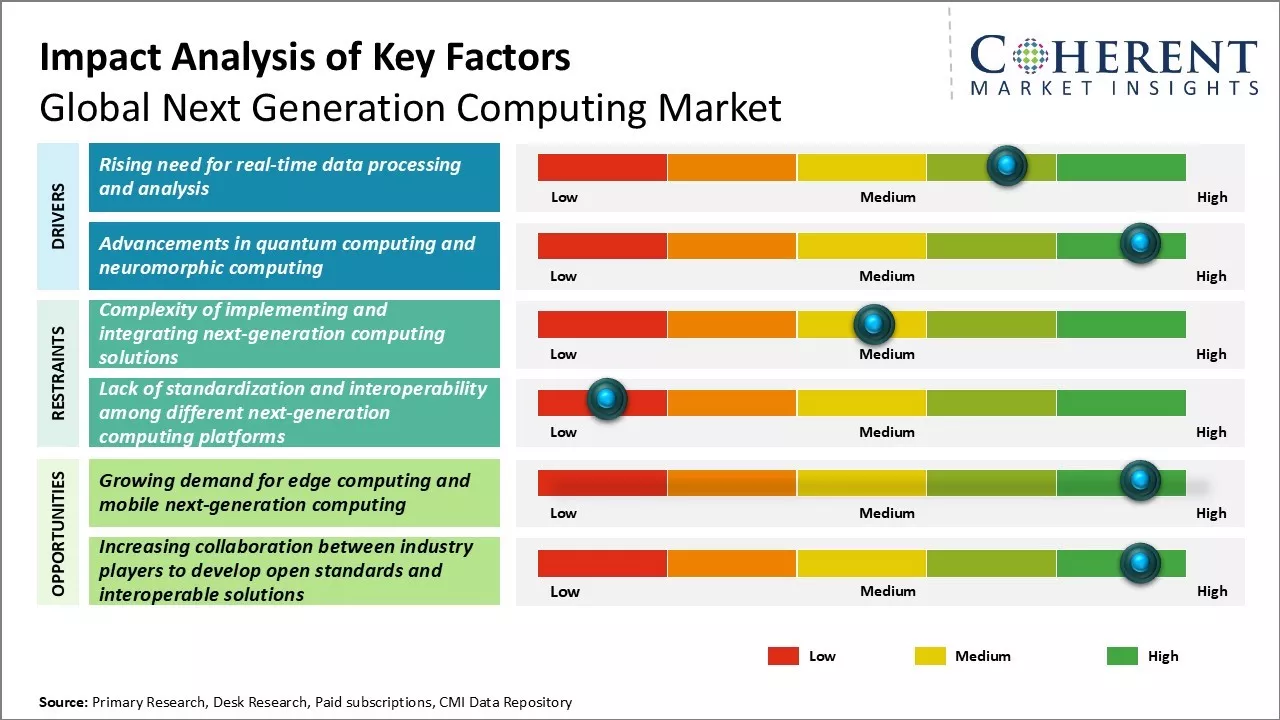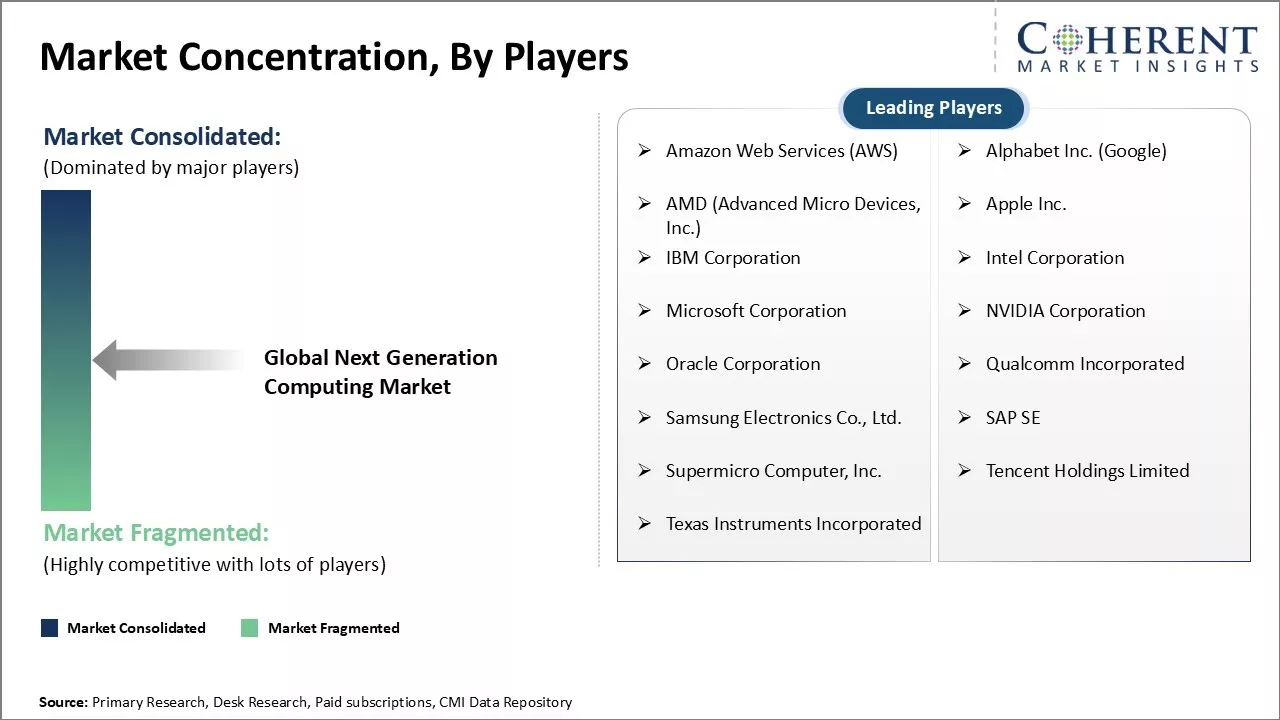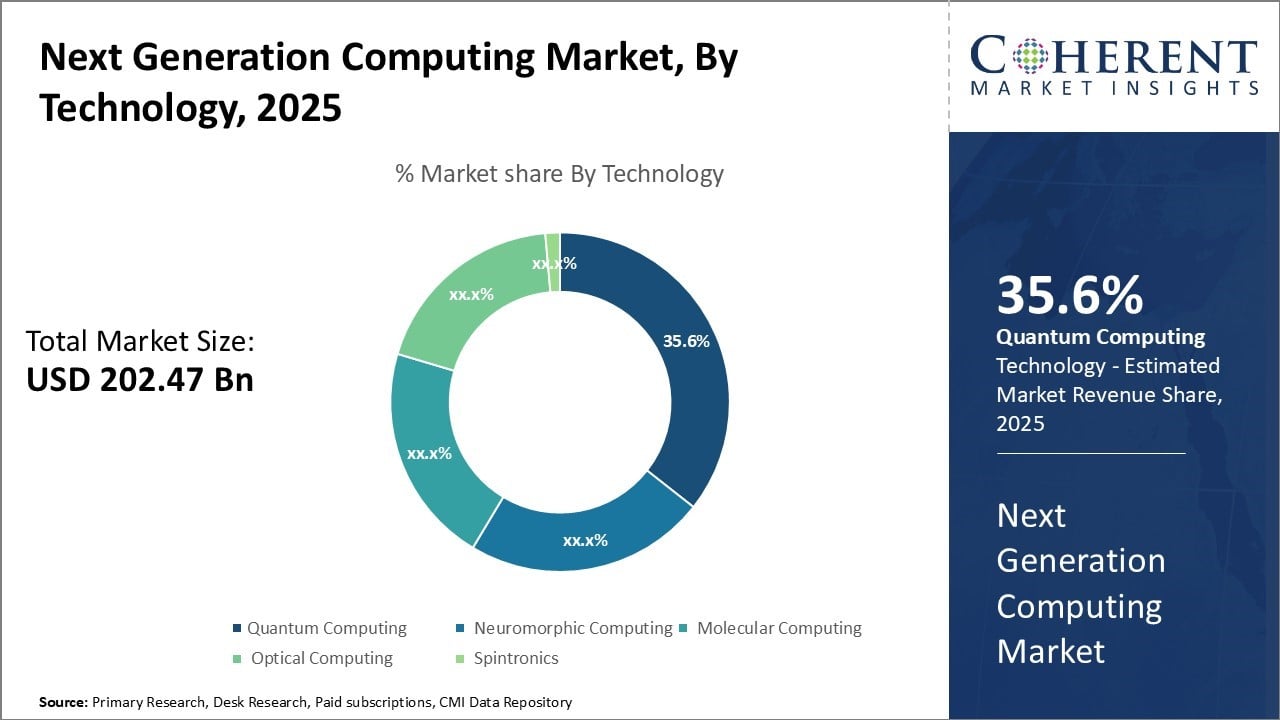Next Generation Computing Market Size and Trends Forecast – 2025 - 2032
The next generation computing market is estimated to be valued at USD 202.47 Bn in 2025 and is expected to reach USD 730.15 Bn by 2032, exhibiting a compound annual growth rate (CAGR) of 20.1% from 2025 to 2032.

To learn more about this report, Download Free Sample
Key Takeaways of the Next Generation Computing Market
- By technology, the quantum computing segment is expected to contribute the highest market share of 35.6% in 2025.
- By application, the artificial intelligence and machine learning segment is expected to contribute the highest market share of 32% in 2025.
- By end user, the IT and telecommunication segment is expected to contribute the highest market share of 43.2% in 2025.
- North America is expected to top the global market with 38.4% share in 2025.
Market Overview
With the exponential growth of data in today's digital era, the ability to process huge amounts of data in real-time has become crucial. Across industry verticals, there is a massive amount of data being generated on a daily basis from sources such as customer transactions, sensor data, mobile users, and much more.
However, processing such large, complex datasets and deriving useful insights from them in real-time presents significant challenges. Traditional computing solutions are struggling to keep up with the data deluge. There is a pressing need among organizations to gain real-time visibility into their business operations and take prompt actions based on insights.
Market Concentration and Competitive Landscape

To learn more about this report, Download Free Sample
Current Events and Its Impact
|
Current Events |
Description and its impact |
|
China’s Semiconductor Self-Sufficiency Drive |
|
|
EU-Japan Strategic Alliances |
|
Uncover macros and micros vetted on 75+ parameters: Get instant access to report
Market Trends
Increasing Adoption of AI and Machine Learning
The increasing adoption of artificial intelligence (AI) and machine learning (ML) is profoundly reshaping the landscape of next-generation computing, acting as a pivotal driver for this market’s expansion. These advanced technologies are enabling systems to process and analyze vast datasets with heightened efficiency and speed, which traditional computing architectures struggle to handle.
For instance, according to the U.S. Data Science Institute, the demand for data science and AI-related roles is projected to grow significantly: Big Data Specialists by 113%, Machine Learning Specialists by 82%, Data Warehousing Specialists by 49%, and Data Analysts and Data Scientists by 41%.
Next Generation Computing Market Insights, by Technology: Quantum Supremacy Drives Quantum Computing Adoption
In terms of technology, quantum computing is expected to hold 35.6% share of the market in 2025, owing to remarkable advancements being achieved with this novel computing approach.
Quantum computing harnesses the principles of quantum mechanics in order to vastly surpass the limitations of classical computing. While classical bits can only hold the values of 0 or 1, quantum bits or "qubits" can exist in superpositions of both states simultaneously. This allows quantum computers to evaluate all possible solutions to a problem simultaneously, instead of sequentially like classical computers.
Next Generation Computing Market Insights, by Application: AI and Machine Learning Ubiquity Fuels the Cryptography and Cybersecurity Demand
In terms of application, artificial intelligence and machine learning is expected to account for 32% share of the market in 2025, due to its widespread usage across numerous industries.
With AI and machine learning being integrated into critical systems and vast amounts of sensitive data being generated every day, cybersecurity has become more crucial than ever. Advanced cryptographic techniques are needed to protect networked infrastructure and data from bad actors exploiting vulnerabilities.
Next Generation Computing Market Insights, by End User: Healthcare Demand Catalyzes Molecular Computing Growth
In terms of end user, the IT and telecommunication segment is expected to hold 43.2% share of the market in 2025. However, the healthcare industry is emerging as a major driving force, especially for molecular computing techniques.
Molecular computing employs biomolecules like DNA/RNA and proteins as building blocks to encode and process information. It aims to develop fundamentally new types of systems that could far surpass digital computers in areas like parallelism, miniaturization, and energy-efficiency.
Emerging Innovations in the Next Generation Computing Market
- The Rise of Quantum Computing
- Unlike traditional classical computers that use bits as the smallest unit of data, quantum computers utilize quantum bits or qubits, which can exist simultaneously in multiple states due to superposition. This allows quantum computers to process complex calculations at speeds unattainable by classical machines. Recent advancements have seen the development of quantum processors with increased qubit counts and improved coherence times.
- Surge in Neuromorphic Computing
- Inspired by the structure and functionality of the human brain, neuromorphic systems use artificial neurons and synapses to enable highly efficient and adaptive processing. These architectures excel in tasks that require pattern recognition, sensory processing, and learning from unstructured data, which traditional von Neumann architectures struggle to handle efficiently. Innovations in memristor technologies and spiking neural networks have propelled neuromorphic chips closer to commercial viability, promising substantial improvements in energy efficiency and processing speeds for AI workloads.
Impacts of Artificial Intelligence (AI) on the Next Generation Computing Market
Major cloud providers and enterprises are leveraging AI to transform computational capabilities, optimize real-time decision-making, and deliver enhanced user experiences. Below are key areas where AI is making a significant impact.
- The launch of Microsoft Azure Cognitive Services showcases an AI solution designed to empower developers with pre-built models for vision, speech, language, and decision-making tasks. By embedding these AI services into applications, businesses can offer more personalized and responsive user experiences.
- NVIDIA, a key player in the computing market, has integrated AI deeply into its chip design and manufacturing processes. NVIDIA’s development of AI-powered GPUs, such as the A100 Tensor Core GPU, leverages machine learning techniques to optimize performance and power efficiency. This integration has allowed NVIDIA to accelerate workloads in data centers and empower AI research, reinforcing its leadership in next generation computing.
Regional Insights

To learn more about this report, Download Free Sample
North America Next Generation Computing Market Analysis and Trends
North America has established itself as the dominant region in the global next generation computing market. The region is expected to hold 38.4% of the market share in 2025. The presence of major industry players from the U.S. such as Intel, Microsoft, IBM, NVIDIA, and AMD has given the region an edge. These companies control a large share of the processor, server, and networking markets which forms the foundation for next generation technologies such as cloud computing, quantum computing, AI, and blockchain.
Asia Pacific Next Generation Computing Market Analysis and Trends
The Asia Pacific region is poised to be the fastest growing market over the forecast period. Countries like China, Japan, India, and South Korea are rapidly adopting next generation technologies. This is due to growing economy, increasing digitization, rising income levels, and urbanization rate that is propelling IT investments. China is emerging as an upcoming leader in this space with the backing of government initiatives for technology innovation and manufacturing facilities of international tech firms.
As per article published in AI Magazine, in October 2023, several key ministries in the people's Republic of China have announced their intention to boost the country's computing power by 50% before 2025. This move is aimed at keeping pace with the U.S. in the fields of artificial intelligence (AI) and supercomputing applications.
U.S. Next Generation Computing Market Analysis and Trends
The U.S. continues to lead the next-generation computing market, driven by its robust infrastructure and technological prowess. The nation's substantial investments in AI, cloud computing, and semiconductor production further solidify its position as a global leader in high-performance computing.
China Next Generation Computing Market Analysis and Trends
China is rapidly emerging as a formidable player in the next-generation computing arena, propelled by strategic government initiatives and substantial investments in AI development. The Chinese government has allocated nearly USD100 billion toward artificial intelligence as part of its national strategy to become a global leader in the technology. China's commitment to advancing AI research and development positions it as a significant competitor in the global tech landscape.
Germany Next Generation Computing Market Analysis and Trends
Germany stands out in Europe for its engineering excellence and commitment to digital transformation, making significant strides in next-generation computing. The country continues to lead in Industry 4.0, combining its manufacturing strength with digital transformation. German automakers are pivoting towards electric and autonomous vehicles, positioning the country as a future mobility leader. Germany's emphasis on industrial automation and clean tech further enhances its role in the next-generation computing landscape.
South Korea Next Generation Computing Market Analysis and Trends
South Korea has established itself as a technological powerhouse, particularly in the semiconductor industry, which is pivotal to next-generation computing. This dominance is underpinned by industry giants like Samsung Electronics and SK Hynix, which play a critical role in global supply chains, particularly in memory chip production and advanced fabrication technologies. South Korea's focus on R&D and investment ensures its continued leadership in the semiconductor sector, a cornerstone of next-generation computing.
Pricing Analysis of the Next Generation Computing Market
- User Pricing Analysis
- Consumer and industrial applications drive demand for affordable edge AI devices.
- Price sensitivity at consumer level restricts devices to <USD 1,000-unit cost.
- Industrial edge deployments involve systems costing USD 2,000 - USD10,000 including integration, sensors, and compute.
Market Report Scope
Next Generation Computing Market Report Coverage
| Report Coverage | Details | ||
|---|---|---|---|
| Base Year: | 2024 | Market Size in 2025: | USD 202.47 Bn |
| Historical Data for: | 2020 To 2024 | Forecast Period: | 2025 To 2032 |
| Forecast Period 2025 to 2032 CAGR: | 20.1% | 2032 Value Projection: | USD 730.15 Bn |
| Geographies covered: |
|
||
| Segments covered: |
|
||
| Companies covered: |
Amazon Web Services (AWS), Alphabet Inc. (Google), AMD (Advanced Micro Devices, Inc.), Apple Inc., IBM Corporation, Intel Corporation, Microsoft Corporation, NVIDIA Corporation, Oracle Corporation, Qualcomm Incorporated, Samsung Electronics Co., Ltd., SAP SE, Supermicro Computer, Inc., Tencent Holdings Limited, and Texas Instruments Incorporated |
||
| Growth Drivers: |
|
||
| Restraints & Challenges: |
|
||
Uncover macros and micros vetted on 75+ parameters: Get instant access to report
Next Generation Computing Industry News
- In March 2025, Amazon Web Services (AWS) announced the next generation of Amazon Connect, where powerful AI turns every customer touchpoint into a deeper relationship and better outcome. This comprehensive approach spans self-service, agent assistance, analytics, post-contact evaluation, and automated follow-up boosts sales and delights customers, while learning from every touchpoint. The next generation of Amazon Connect can be enabled with a single click, and includes unlimited use of AI capabilities.
- In March 2025, building longstanding partnership, NVIDIA, Alphabet, and Google announced new initiatives to advance AI, democratize access to AI tools, speed the development of physical AI and transform industries including healthcare, manufacturing and energy.
- In June 2025, Advanced Micro Devices, Inc. delivered its comprehensive, end-to-end integrated AI platform vision and introduced its open, scalable rack-scale AI infrastructure built on industry standards at its 2025 Advancing AI event.
- In June 2025, Apple announced new technologies and enhancements to its developer tools to help developers create more beautiful, intelligent, and engaging app experiences across Apple platforms. A beautiful new software design brings more focus to content, and delivers more expressive and delightful experiences across iOS 26, iPadOS 26, macOS Tahoe 26, watchOS 26, and tvOS 26,1 while keeping them all instantly familiar.
Analyst View
- The next generation computing market is poised for transformative growth, driven by rapid advancements in quantum computing, artificial intelligence, and edge computing technologies. Increasing demand for enhanced computational power and faster data processing capabilities is fueling investments from both public and private sectors.
- The proliferation of IoT devices and the need for real-time analytics are further accelerating the adoption of next-generation computing solutions across industries such as healthcare, finance, and manufacturing.
- However, challenges such as high implementation costs and technical complexities associated with quantum hardware and software integration remain significant restraints. Additionally, concerns around data security and privacy in decentralized computing environments could slow down adoption rates. Despite these hurdles, opportunities abound in leveraging next-generation computing for complex problem-solving, drug discovery, and climate modeling.
- Geographically, North America continues to dominate the market, due to the presence of major technology players and robust R&D infrastructure. Meanwhile, the Asia Pacific region is emerging as the fastest-growing market, driven by increasing technology adoption in countries like China, Japan, and India, coupled with supportive government initiatives and growing startup ecosystems.
Market Segmentation
- By Technology Insights (Revenue, USD Billion, 2020 - 2032)
- Quantum Computing
- Neuromorphic Computing
- Molecular Computing
- Optical Computing
- Spintronics
- By Application Insights (Revenue, USD Billion, 2020 - 2032)
- Artificial Intelligence and Machine Learning
- Cryptography and Cybersecurity
- Simulation and Modeling
- Scientific Research
- Others (Logistics, Finance, Healthcare, etc.)
- By End User Insights (Revenue, USD Billion, 2020 - 2032)
- IT and Telecommunication
- Healthcare
- Aerospace and Defense
- BFSI (Banking, Financial Services, and Insurance)
- Others
- By Regional Insights (Revenue, USD Billion 2020 - 2032)
- North America
- U.S.
- Canada
- Latin America
- Brazil
- Argentina
- Mexico
- Rest of Latin America
- Europe
- Germany
- U.K.
- Spain
- France
- Italy
- Russia
- Rest of Europe
- Asia Pacific
- China
- India
- Japan
- Australia
- South Korea
- ASEAN
- Rest of Asia Pacific
- Middle East
- GCC Countries
- Israel
- Rest of Middle East
- Africa
- South Africa
- North Africa
- Central Africa
- Key Players Insights
- Amazon Web Services (AWS)
- Alphabet Inc. (Google)
- AMD (Advanced Micro Devices, Inc.)
- Apple Inc.
- IBM Corporation
- Intel Corporation
- Microsoft Corporation
- NVIDIA Corporation
- Oracle Corporation
- Qualcomm Incorporated
- Samsung Electronics Co., Ltd.
- SAP SE
- Supermicro Computer, Inc.
- Tencent Holdings Limited
- Texas Instruments Incorporated
Sources
Primary Research Interviews
- IT Infrastructure Heads
- Cloud Computing Solution Providers
- Data Center Managers
- Technology Analysts
- Others
Magazines
- Wired
- TechCrunch
- CIO Magazine
- IEEE Spectrum
- Others
Journals
- Journal of Parallel and Distributed Computing
- ACM Transactions on Computer Systems
- IEEE Transactions on Cloud Computing
- Others
Newspapers
- The Wall Street Journal
- Financial Times
- The Economic Times
- The New York Times
- Others
Associations
- IEEE Computer Society
- Association for Computing Machinery (ACM)
- Cloud Security Alliance
- International Data Corporation (IDC)
Public Domain Sources
- U.S. Department of Energy Reports
- World Economic Forum Publications
- National Institute of Standards and Technology (NIST)
- International Telecommunication Union (ITU)
- Others
Proprietary Elements
- CMI Data Analytics Tool – Next Generation Computing Market
- CMI Existing Repository of Information for the Last 8 Years
*Definition: The global next generation computing market consists of companies involved in developing innovative new computing technologies that go beyond existing platforms and represent major advances compared to today's systems. This includes developments in quantum computing, digital intelligence, digital convergence, cloud/edge computing, and advanced architectures like neuromorphic computing that aim to achieve new levels of performance to solve complex problems.
Share
Share
About Author
Ankur Rai is a Research Consultant with over 5 years of experience in handling consulting and syndicated reports across diverse sectors. He manages consulting and market research projects centered on go-to-market strategy, opportunity analysis, competitive landscape, and market size estimation and forecasting. He also advises clients on identifying and targeting absolute opportunities to penetrate untapped markets.
Missing comfort of reading report in your local language? Find your preferred language :
Transform your Strategy with Exclusive Trending Reports :
Frequently Asked Questions
EXISTING CLIENTELE
Joining thousands of companies around the world committed to making the Excellent Business Solutions.
View All Our Clients


